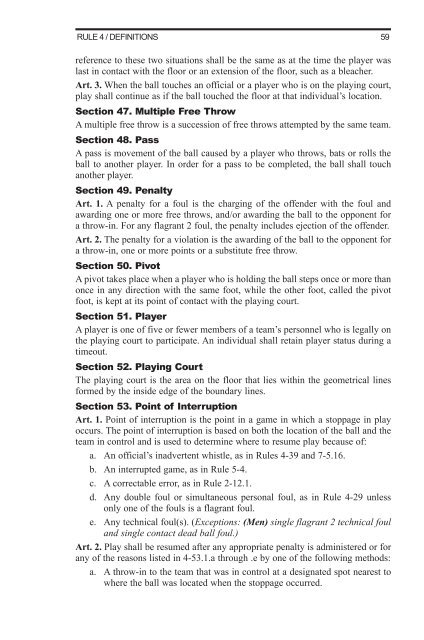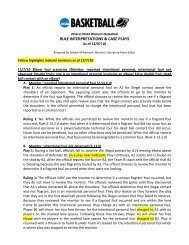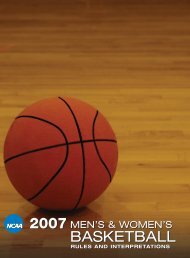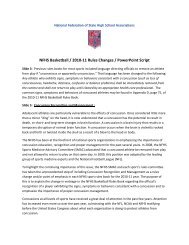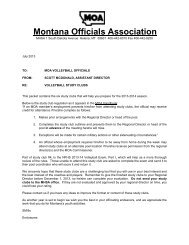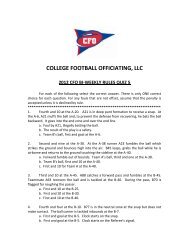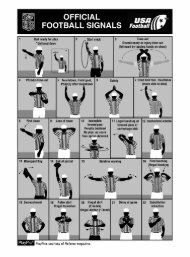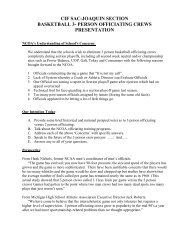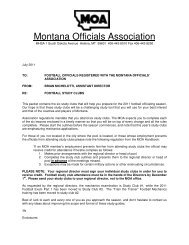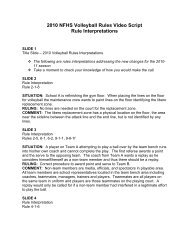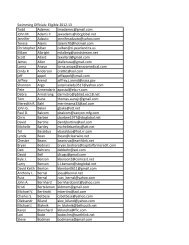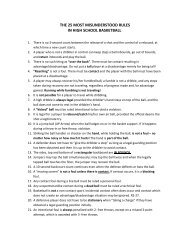2011-12 AND 2012-13 MEN'S AND WOMEN'S RULES - NAIA
2011-12 AND 2012-13 MEN'S AND WOMEN'S RULES - NAIA
2011-12 AND 2012-13 MEN'S AND WOMEN'S RULES - NAIA
You also want an ePaper? Increase the reach of your titles
YUMPU automatically turns print PDFs into web optimized ePapers that Google loves.
RULE 4 / DEFINITIONS59<br />
reference to these two situations shall be the same as at the time the player was<br />
last in contact with the floor or an extension of the floor, such as a bleacher.<br />
Art. 3. When the ball touches an official or a player who is on the playing court,<br />
play shall continue as if the ball touched the floor at that individual’s location.<br />
Section 47. Multiple Free Throw<br />
A multiple free throw is a succession of free throws attempted by the same team.<br />
Section 48. Pass<br />
A pass is movement of the ball caused by a player who throws, bats or rolls the<br />
ball to another player. In order for a pass to be completed, the ball shall touch<br />
another player.<br />
Section 49. Penalty<br />
Art. 1. A penalty for a foul is the charging of the offender with the foul and<br />
awarding one or more free throws, and/or awarding the ball to the opponent for<br />
a throw-in. For any flagrant 2 foul, the penalty includes ejection of the offender.<br />
Art. 2. The penalty for a violation is the awarding of the ball to the opponent for<br />
a throw-in, one or more points or a substitute free throw.<br />
Section 50. Pivot<br />
A pivot takes place when a player who is holding the ball steps once or more than<br />
once in any direction with the same foot, while the other foot, called the pivot<br />
foot, is kept at its point of contact with the playing court.<br />
Section 51. Player<br />
A player is one of five or fewer members of a team’s personnel who is legally on<br />
the playing court to participate. An individual shall retain player status during a<br />
timeout.<br />
Section 52. Playing Court<br />
The playing court is the area on the floor that lies within the geometrical lines<br />
formed by the inside edge of the boundary lines.<br />
Section 53. Point of Interruption<br />
Art. 1. Point of interruption is the point in a game in which a stoppage in play<br />
occurs. The point of interruption is based on both the location of the ball and the<br />
team in control and is used to determine where to resume play because of:<br />
a. An official’s inadvertent whistle, as in Rules 4-39 and 7-5.16.<br />
b. An interrupted game, as in Rule 5-4.<br />
c. A correctable error, as in Rule 2-<strong>12</strong>.1.<br />
d. Any double foul or simultaneous personal foul, as in Rule 4-29 unless<br />
only one of the fouls is a flagrant foul.<br />
e. Any technical foul(s). (Exceptions: (Men) single flagrant 2 technical foul<br />
and single contact dead ball foul.)<br />
Art. 2. Play shall be resumed after any appropriate penalty is administered or for<br />
any of the reasons listed in 4-53.1.a through .e by one of the following methods:<br />
a. A throw-in to the team that was in control at a designated spot nearest to<br />
where the ball was located when the stoppage occurred.


